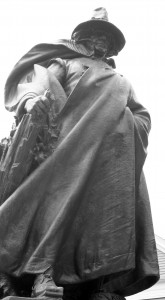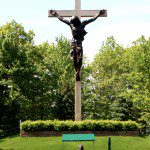
When last we met here at The Holy Rover, Emerson, Thoreau, and the rest of the gang were resting quietly in Sleepy Hollow Cemetery in Concord. We’ll leave them there in peace while we head eastward 30 miles to Salem, an Atlantic seacoast town where the ghosts don’t rest so quietly.
If you remember, there’s a link between the two towns in Nathaniel Hawthorne, author of The Scarlet Letter and descendent of one of the judges in the Salem Witch Trials. Hawthorne was America’s great chronicler of the Puritan soul, a man haunted by what had happened in his hometown two centuries before.
First, a few words about modern Salem. I’ve talked to a number of visitors to Salem who didn’t care for the place, finding its kitchy-witschy tourism a bit over the top. As regular readers know, I have a high tolerance for such things, and I was mainly amused by the plentiful signs for psychics and tarot readings and restaurants named The Witch’s Brew.
I also have considerable sympathy for Salem’s dilemma. A terrible mass murder happened there in 1692-93, but it is a tragedy whose intensity has been muted by the passage of time. For us modern humans, witches bring to mind Harry Potter and dressing up on Halloween (and for those of us of a certain vintage, Samantha of the TV show Bewitched). The idea that people could get killed for being thought a witch strikes us as ludicrous.
But of course, people did get killed, not just in Salem but throughout Europe. And for some, that fact still has a powerful resonance. One of the regular readers of this blog, my friend Anne, is descended from one of the women killed at Salem, and for her the place rightly evokes a profound sense of injustice, not light-hearted fun.

That said, there’s no denying that Salem blends history, tragedy, and whimsy in an entertaining—if somewhat disconcerting—way. I enjoyed my time there, and over the next few days will give you a sense for why you might profit from a visit there too.
There’s much more than just witch history in Salem, for the town was once one of the richest seaports in North America and has a wonderful maritime museum run by the National Park Service (which includes a replica of the 1797 Friendship sailing ship). It’s home to the Peabody Essex Museum, the House of the Seven Gables (which inspired Hawthorne’s novel), and the Schooner Fame (a full-scale replica of an 1812 privateer that offers sailing cruises).
But I must admit that as a Christian, I find that Salem’s ghosts make me uneasy, for surely it represents one of the darkest chapters in Christian history in America. The intolerance, ignorance, bigotry, bullying, and sheer awfulness of what happened in Salem have been a black mark on Christianity for three centuries.
At the same time, what happened at Salem is a microcosm of what has happened again and again in human history–the scapegoating of the innocent, the abuse of the vulnerable, and the hysteria of a mob. It’s appropriate that Elie Wiesel, Holocaust survivor and author, led the campaign to establish a monument to the victims of the Salem witch trials. He recognized the similarities between what had happened to them and what had happened to the Jews of Europe under the Nazis.
I think knowing something about what happened in Salem is a good thing for all us. Join me, won’t you, as we go searching for the truth about the Witches of Salem?











